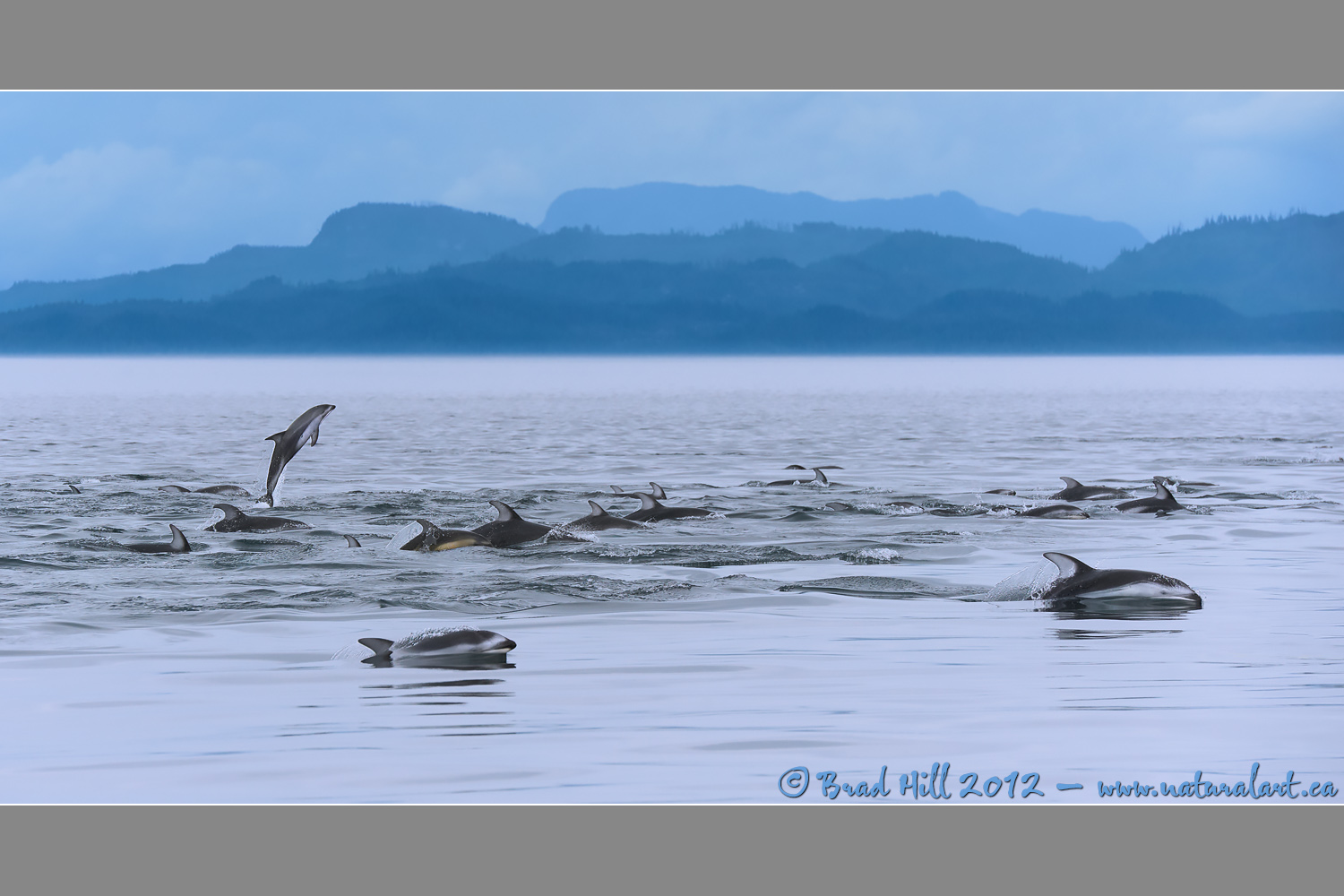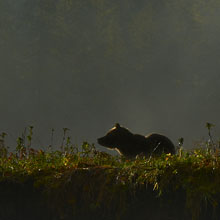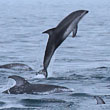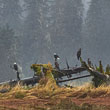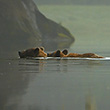Availability: Limited Edition Print - info coming soon!
In the Field
Band of Thugs. Northern Vancouver Island, BC, Canada. August 23, 2012.
One of my favourite animalscapes* from 2012...
Dolphins have a reputation for being "fun-loving" animals - many dolphin species will ride the bow waves of boats and engage other aquatic mammals in what many consider play. While the "fun-loving" reputation does appear to be deserved when you watch them, I suspect this view is perhaps a bit too anthropomorphic and that something a little more nefarious is going on.
While touring the waters around the northern tip of Vancouver Island in August of 2012 we had the privilege of encountering a "super-pod" of about 200-300 Pacific White-sided Dolphins on two consecutive days. The region is exceptionally rich biologically, and while we were watching and photographing the dolphins we had a number of other species aquatic mammals within eyesight, including killer whales, humpback whales, and Steller sea lions. Having this huge group of dolphins "mob" our boat was impressive enough, but watching the group shift their attention from us to another "target", and then absolutely swarm the killer whales, humpbacks and sea lions was beyond fascinating. In this shot the dolphins have lost interest in us and are just leaving to go engage with a killer whale and its calf.
The "they're just playing" view of the interactions between the dolphins and the other species we observed them mobbing is pleasing to us. But, when you see how all the other species absolutely high-tail it when the dolphins close in suggests it isn't a whole lot of fun for the "victims" of the mobbing. Interestingly, ALL the species that we watched the dolphins harass eat fish, and have at least some overlap with the diet of the fish-eating dolphins. I suspect that the mobbing of the other species has more to do with removing food competitors from the vicinity than having some fun with them. Simply put, before long these dolphins seemed to be nothing more than a real "band of thugs!"
So what about those bow-riding dolphins - why do they do that? Well, after watching it many times I'm leaning toward the view that the EXACT same thing is motivating the dolphins when they're bow-riding and mobbing a boat - after all, what better way to get rid of a competitor or threat than mobbing its head (as I'm sure the bow of a boat appears to a dolphin)? Just a thought...
But enough biology...back to the photography! It was no accident that I captured this portion of the super pod with the great backdrop. I had to lay on the deck of our boat to get this low and include the dolphins and distant ridges in the frame. I also used a shorter focal length lens than I often do (in this case a 70-200mm zoom) to include a wider angle of view - both so that I could capture the distant ridges and to increase the probability of capturing one or more dolphins when they breached. And, of course, patience - to get the right "configuration" of subjects, a high shutter speed to freeze the action, and a comparatively narrow aperture for a wide depth of field, all contributed to the "formula" I used to capture this image. The particular region we were in when I shot this often is sunny (but slightly misty) and calm, which gives you wonderful lighting and almost pewter-coloured water (with hints of blue in it) to work with.
Oh, and one last thing - the one dolphin with the yellow-orange side is a young calf swimming beside its mother (both killer whale and some species of dolphins bear young where the portions of the body destined to become white are initially yellow-orange).
Here's a higher resolution (2400 pixel) version of this amazing scene:
• Band of Thugs: Download 2400 pixel image (JPEG: 0.88 MB)
ADDITIONAL NOTES:
1. This image - in all resolutions - is protected by copyright. I'm fine with personal uses of it (including use as desktop backgrounds or screensavers on your own computer), but unauthorized commercial use of the image is prohibited by law. Thanks in advance for respecting my copyright!
2. Like all wildlife photographs on this website, this image was captured following the strict ethical guidelines described in The Wildlife FIRST! Principles of Photographer Conduct. I encourage all wildlife photographers to always put the welfare of their subjects above the value of their photographs.
3. This image was captured during my "Humpback, Orcas, Sea Lions & More" photo tour in August of 2012. Each year I offer trips into two different parts of the Great Bear Rainforest as well as one to photograph aquatic mammals and oceanscapes near the northern tip of Vancouver Island. And, in selected years, I also offer photo tours to locations to capture other highly sought-after subjects, such as various owl species of the boreal forest and wildlife of Canada's Arctic. Details about these trips can be found on the Photo Tours page of this website.
*4. For a discussion of the image types I call animalscapes and enviroscapes (and the subtle distinctions between them), just go here...
Behind the Camera
Band of Thugs. Northern Vancouver Island, BC, Canada. August 23, 2012.
Digital Capture; RAW 14-bit format; ISO 900.
Nikon D4 paired with Nikkor 70-200mm f2.8 VRII lens. Hand-held from sailboat. VR on and set to "normal" mode.
1/2000s @ f8; +0.33 stop compensation from matrix-metered exposure setting.
At the Computer
Band of Thugs. Northern Vancouver Island, BC, Canada. August 23, 2012.
RAW Conversion to 16-bit TIFF, including first-pass/capture sharpening using Capture One Pro. Three raw variants (processed from raw) differing by a total of 1.0 stops in exposure - from -0.5 stops from original exposure to +0.5 stops from original exposure.
Further digital corrections on resulting 16-bit TIFF files using Adobe's Photoshop CS6 and Light Craft's Lightzone. Photoshop adjustments including compositing the raw conversion variants (layering and masking), selective colour saturation and desaturation, additional minor selective exposure adjustments, selective curves adjustment to distant ridges and sky (to separate out mid-tones) and selective sharpening for web output. Final tone tweaking performed using tonemapper/re-light tool in Lightzone.
Conservation
Band of Thugs. Northern Vancouver Island, BC, Canada. August 23, 2012.
Ten percent of the revenue generated by this image will be donated to Raincoast*.
Species Status in Canada**: Not listed as Endangered, Threatened, or of "Special Concern"
Nicknamed the "Lag", the Pacific White-sided Dolphin (Lagenorhynchus obliquidens) is known for its exuberance and is one of the liveliest dolphins in the northern Pacific. They commonly leap clear of the water, perform flips and somersaults, and will often approach and ride the bow waves of ships.
Lags will often form schools of 1,000 or more individuals. Their social lives are dynamic, with groups frequently joining together and breaking apart. Even though both sharks and killer whales commonly feed on them, they frequently have long life spans and some have lived for 40 or more years in the wild!
*The Raincoast Conservation Society (and Foundation) is an effective and efficient organization that has been fighting for protection of this unique habitat. If you are looking for a meaningful way to contribute to the conservation of this amazing ecosystem, Raincoast will provide maximal "bang" for your conservation dollars.
**as determined by COSEWIC: The Committee on the Status of Endangered Wildlife in Canada













